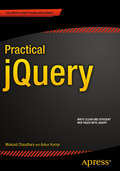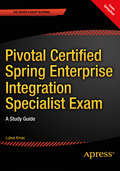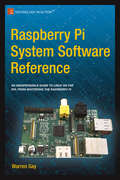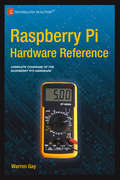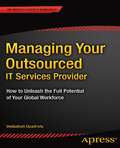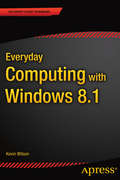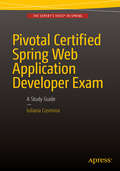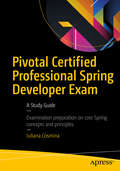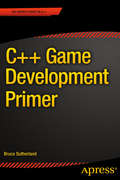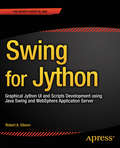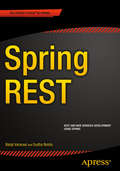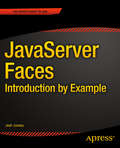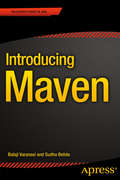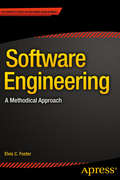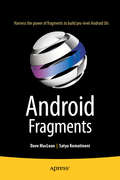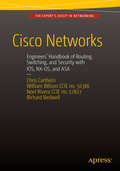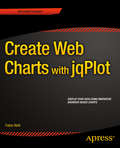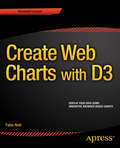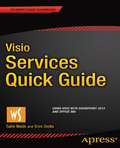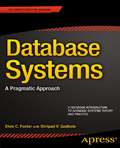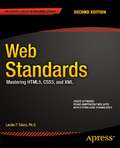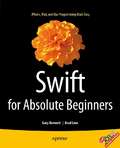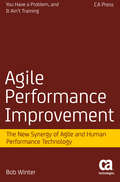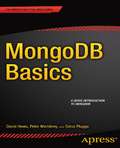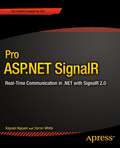- Table View
- List View
Practical jQuery
by Ankur Kumar Mukund ChaudharyPractical jQuery is your step-by-step guide to using jQuery in the real world, taking you from downloading jQuery all the way to extending it by writing your own plug-ins and testing the DOM using QUnit. jQuery is one of today’s most popular JavaScript web application development frameworks and libraries. While getting started with the tool is easy, sometimes it's not as simple to completely realize the power and automation that it can bring to your development work—and that's especially the case when you're in the middle of a project, up against a deadline.Using this book, you will learn how to use jQuery’s powerful DOM manipulation tools to dynamically update content on your site. You will be able to extend jQuery’s capabilities by writing your own plugins on top of the framework, animate elements, build your own jQuery elements, employ best practices, and avoid common errors. Practical jQuery teaches you how, with jQuery, you can unit test and refactor your code. You’ll see how expressive yet concise jQuery’s code is and how much quicker and efficient it is to develop with jQuery.Get a fundamental perspective on how jQuery works, how to understand, select, and build your own plug-ins, and how to make sure your projects run at the peak of their potential performance using Practical jQuery today.
Pivotal Certified Spring Enterprise Integration Specialist Exam: A Study Guide
by Lubos KrnacExam topics covered include tasks and scheduling, remoting, the Spring Web Services framework, RESTful services with Spring MVC, the Spring JMS module, JMS and JTA transactions with Spring, batch processing with Spring Batch and the Spring Integration framework. Prepare with confidence for the Pivotal Enterprise Integration with Spring Exam.One of the important aspects of this book is a focus on new and modern abstractions provided by Spring. Therefore most of the features are shown with Java annotations alongside established XML configurations. Most of the examples in the book are also based on the Spring Boot framework. Spring Boot adoption is exponential because of its capability to significantly simplify Spring configuration using sensible opinionated defaults. But Spring Boot is not the target of the exam, therefore all the features are also covered with plain Spring configuration examples.How to use Spring to create concurrent applications and schedule tasksHow to do remoting to implement client-server applicationsHow to work with Spring Web services to create loosely coupled Web services and clientsHow to use Spring MVC to create RESTful web services and clientsHow to integrate JMS for asynchronous messaging-based communicationHow to use local JMS transactions with SpringHow to configure global JTA transactions with SpringHow to use Spring Integration to create event-driven pipes-and-filters architectures and integrate with external applicationsHow to use Spring Batch for managed, scalable batch processing that is based on both custom and built-in processing components
Raspberry Pi System Software Reference
by Warren GayRaspberry Pi is Linux, but it's a unique flavor of Linux, specifically for the ARM-based Pi. Raspberry Pi Software Reference guides you through the boot process, including options for tweaking HDMI, memory, and other boot options. You'll learn the details of run levels and creating new services, and how to use the custom command vcgencmd for doing things like reporting temperature, clock speeds, and voltage. And while there are cross-compilers available for some flavors of Linux, one of the most important things you'll get from Raspberry Pi Software Reference is how to build your own Raspberry Pi cross-compiler on your Mac OSX, Linux, or Windows computer.
Raspberry Pi Hardware Reference
by Warren GayThe Raspberry Pi is deceptively simple. Plug it in, boot it up, and use it as a personal computer, or attach a million gizmos and modules and invent something new and amazing. Either way, what it can actually do is not simple, and you should know exactly what the Raspberry Pi hardware is all about. Raspberry Pi Hardware Reference, from Mastering the Raspberry Pi, is the hardware guide you need on your desk or workbench. Every detail is covered: from power to memory, from the CPU to working with USB. You'll find all the details about working with both wired and wireless Ethernet, SD cards, and the UART interface. The GPIO chapter is invaluable, covering power budgeting, access, and even small but important details like the correct usage of sudo when working with GPIO pins. You'll also find details about the 1-Wire driver, the I2C bus, and the SPI bus. If you need to know anything about your Raspberry Pi's hardware, you will find it here, in Raspberry Pi Hardware Reference.
Managing Your Outsourced IT Services Provider: How to Unleash the Full Potential of Your Global Workforce
by Venkatesh UpadristaManaging Your Outsourced IT Services Provider teaches executives and managers of organizations how to unleash the full potential of their outsourced IT services workforce and IT-enabled business processes safely and profitably. Drawing on two decades of experience managing client relationships for global IT services companies, Venkatesh Upadrista guides outsourcing organizations around the hazards of geographic distance, linguistic miscommunication, organizational mismatch, and functional disparity between receiver requirements and provider capabilities.The first half of the book describes what an outsourcing organization needs to know about the IT services providers industry in general to deal intelligently with specific providers: namely, the industry’s organizational types, strategic drivers, competitive labor market constraints, and tactics for hitting P&L targets. The second half of the book teaches outsourcers how to evaluate prospective providers, craft service level agreements, formalize best practices, and manage the full gamut of receiver─provider relationships to optimize outcome in terms of cost, timeliness, and quality of services received.The descriptions and prescriptions in Managing Your Outsourced IT Services Provider apply equally to onshore and offshore outsourcing, but examples and case studies focus on offshoring. In addition, Upadrista analyzes the advantages, disadvantages, and special considerations and caveats of single provider outsourcing and captive centers.
Everyday Computing with Windows 8.1
by Kevin WilsonGet the most out of Windows 8.1 for your every day computing tasks, with no jargon. Clear, concise and to the point. This brief book, Everyday Computing With Windows 8.1 provides the essentials of using a desktop or laptop running Windows 8 or 8.1, providing a fast read for the beginner and the enthusiast. Windows 8 can give new users fits with options that are well hidden; this book uncovers those so that the user can be relieved of frustration.Techniques are illustrated step-by-step using photography and screen prints throughout, together with concise, easy to follow explanations from an established expert in the field.Whether you have just bought your first computer or laptop or are a computer user who needs a better understanding of the basics, this book will provide you with a firm grasp of the underpinning foundations and equip you with the skills needed to take command of your computer.
Pivotal Certified Spring Web Application Developer Exam: A Study Guide
by Iuliana CosminaPrepare for the Pivotal Certified Spring Web Application Developer exam and learn about Spring MVC DispatcherServlet configuration, Spring MVC programming model essentials, Spring MVC views and form processing, Spring Web Flow essentials, and Spring Web Flow actions and configuration. The Pivotal Certified Spring Web Application Developer Exam: A Study Guide is the ideal preparation for the exam and after reading and using it, you'll be able to pass and become a certified Spring Web Developer. When you become a Pivotal Certified Spring Web Application Developer, you'll receive one of the most valuable credentials available in enterprise Java. Achieving this certification demonstrates your ability to apply Spring's web projects to develop real-world Java web applications and validates your familiarity with Spring Web.
Pivotal Certified Professional Spring Developer Exam: A Study Guide
by Iuliana CosminaPass the Pivotal Certified Professional exam using source code examples, study summaries, and mock exams. In this book, you'll find a descriptive overview of certification-related Spring modules and a single example application demonstrating the use of all required Spring modules. Also, it is suitable as an introductory primer for Spring newcomers.Furthermore, in Pivotal Certified Professional Spring Developer Exam: A Study Guide each chapter contains a brief study summary and question set, and the book’s free downloadable source code package includes one mock exam (50 questions – like a real exam). After using this study guide, you will be ready to take and pass the Pivotal Certified Professional exam.When you become Pivotal Certified, you will have one of the most valuable credentials in Java. The demand for Spring skills is skyrocketing. Pivotal certification helps you advance your skills and your career, and get the maximum benefit from Spring. Passing the exam demonstrates your understanding of Spring and validates your familiarity with: container-basics, aspect oriented programming (AOP), data access and transactions, Spring Security, Spring Boot, microservices and the Spring model-view-controller (MVC). Good luck!What You'll LearnUnderstand the core principles of the popular Spring FrameworkUse dependency injectionWork with aspects in Spring and do AOP (aspect oriented programming)Control transactional behavior and work with SQL and NoSQL (MongoDB) databasesCreate and secure web applications based on Spring MVCGet to know the format of exam and type of questions in itCreate Spring microservices applicationsWho This Book Is ForSpring developers who have taken the Pivotal Core Spring class are eligible to take the Pivotal Certified Professional exam.
C++ Game Development Primer
by Bruce SutherlandC++ is the language behind most of today's computer games. This 96-page C++ Game Development Primer takes you through the accelerated process of writing games for otherwise experienced C++ programmers. After reading this book, you’ll have the fundamental know-how to become a successful and profitable game applications developer in today’s increasingly competitive indie game marketplace.For those looking for a quick introduction to C++ game development and who have good skills in C++, this will get you off to a fast start. C++ Game Development Primer is based on Learn C++ for Game Development by the same author, giving you the essentials to get started in game programming without the unnecessary introduction to C++.
Swing for Jython: Graphical Jython UI and Scripts Development using Java Swing and WebSphere Application Server
by Robert GibsonThis book shows you how to use Swing to add a GUI to your Jython scripts, with an emphasis on the WebSphere Application Server wsadmin utility. In fact, we're going to teach you Swing using Jython, and we're going to do it in a way that, hopefully, that makes your scripts easier for people to use, more robust, more understandable, and therefore easier to maintain.
Spring REST
by Balaji Varanasi Sudha BelidaSpring REST is a practical guide for designing and developing RESTful APIs using the Spring Framework. This book walks you through the process of designing and building a REST application while taking a deep dive into design principles and best practices for versioning, security, documentation, error handling, paging, and sorting. This book provides a brief introduction to REST, HTTP, and web infrastructure. You will learn about several Spring projects such as Spring Boot, Spring MVC, Spring Data JPA, and Spring Security and the role they play in simplifying REST application development. You will learn how to build clients that consume REST services. Finally, you will learn how to use the Spring MVC test framework to unit test and integration test your REST API. After reading this book, you will come away with all the skills to build sophisticated REST applications using Spring technologies.
JavaServer Faces: Introduction By Example
by Josh JuneauThis book is about using JavaServer Faces to create and deploy interactive applications delivered to end users via a browser interface. JavaServer Faces is the component-based technology enabling easy development of such applications, especially applications of the type commonly needed in enterprise environments. JavaServerFaces: Introduction by Example is a to-the-point, 250-page introduction to an important technology that every Java Enterprise Edition programmer should know and be able to use.JavaServer Faces: Introduction by Example takes you through building and deploying servlet-based web pages built around JavaServer Faces, Facelets, managed Java Beans, and prebuilt user-interface components. You'll learn to build user interfaces that run in the browser, to display data drawn from corporate databases, accept user input, deal with errors and exceptions, and more. JavaServer Faces is an important user-interface technology for any Java developer to learn who works in an enterprise environment. JavaServer Faces: Introduction by Example is your no-nonsense guide to getting started right away in taking advantage of the technology's component-driven approach.Introduces servlets, which are the basis for JavaServer Faces applicationsCovers development and deployment of user interfaces in the browserDemonstrates advanced techniques such as the use of AJAX
Introducing Maven
by Balaji Varanasi Sudha BelidaIntroducing Maven is your quick start-up primer guide on Maven. This fully packed mini-book includes the new features and enhancements found in the latest version of Maven. In this short 100-page book, you'll learn all about Maven and how to set it up to use. You'll learn about the Maven life cycle and how to effectively leverage and use it. Also, you'll learn the basics of using site plugins and generating Javadocs, test coverage/FindBugs reports, version/release notes and more. Furthermore, you'll take advantage of Maven's archetypes to bootstrap new projects easily. Finally, you will learn how to integrate Nexus repository manager with Maven release phases. After reading and using this short book, you'll have an understanding of Maven’s dependency management and how to organize basic and multi-module Maven projects.
Software Engineering: A Methodical Approach
by Elvis FosterThis text provides a comprehensive, but concise introduction to software engineering. It adopts a methodical approach to solving software engineering problems proven over several years of teaching, with outstanding results.The book covers concepts, principles, design, construction, implementation, and management issues of software systems. Each chapter is organized systematically into brief, reader-friendly sections, with itemization of the important points to be remembered. Diagrams and illustrations also sum up the salient points to enhance learning. Additionally, the book includes a number of the author’s original methodologies that add clarity and creativity to the software engineering experience, while making a novel contribution to the discipline.Upholding his aim for brevity, comprehensive coverage, and relevance, Foster’s practical and methodical discussion style gets straight to the salient issues, and avoids unnecessary topics and minimizes theoretical coverage.
Android Fragments
by Dave MacLean Satya KomatineniAndroid Fragments is a 100-page quick start accelerated guide to learning and quickly using Android fragments. You'll learn how to code for fragments; deal with config changes; code for regular vs. fragmented dialogs; work with preferences and saving state; work with the compatibility library; and handle advanced async tasks and progress dialogs.After reading and using this book, which is based on material from the best-selling Pro Android, you'll be an Android UI savant. At the very least, your apps' user interfaces and event handling will be more competitive and better performing, especially for tablet-optimized UIs and events.
Cisco Networks: Engineers' Handbook of Routing, Switching, and Security with IOS, NX-OS, and ASA
by Chris Carthern William Wilson Noel Rivera Richard BedwellThis book is a concise one-stop desk reference and synopsis of basic knowledge and skills for Cisco certification prep. For beginning and experienced network engineers tasked with building LAN, WAN, and data center connections, this book lays out clear directions for installing, configuring, and troubleshooting networks with Cisco devices. The full range of certification topics is covered, including all aspects of IOS, NX-OS, and ASA software. The emphasis throughout is on solving the real-world challenges engineers face in configuring network devices, rather than on exhaustive descriptions of hardware features.This practical desk companion doubles as a comprehensive overview of the basic knowledge and skills needed by CCENT, CCNA, and CCNP exam takers. It distills a comprehensive library of cheat sheets, lab configurations, and advanced commands that the authors assembled as senior network engineers for the benefit of junior engineers they train, mentor on the job, and prepare for Cisco certification exams. Prior familiarity with Cisco routing and switching is desirable but not necessary, as Chris Carthern, Dr. Will Wilson, Noel Rivera, and Richard Bedwell start their book with a review of the basics of configuring routers and switches. All the more advanced chapters have labs and exercises to reinforce the concepts learned. This book differentiates itself from other Cisco books on the market by approaching network security from a hacker’s perspective. Not only does it provide network security recommendations but it teaches you how to use black-hat tools such as oclHashcat, Loki, Burp Suite, Scapy, Metasploit, and Kali to actually test the security concepts learned. Readers of Cisco Networks will learn How to configure Cisco switches, routers, and data center devices in typical corporate network architecturesThe skills and knowledge needed to pass Cisco CCENT, CCNA, and CCNP certification examsHow to set up and configure at-home labs using virtual machines and lab exercises in the book to practice advanced Cisco commandsHow to implement networks of Cisco devices supporting WAN, LAN, and data center configurationsHow to implement secure network configurations and configure the Cisco ASA firewallHow to use black-hat tools and network penetration techniques to test the security of your network
Create Web Charts with jqPlot
by Fabio NelliCreate Web Charts with jqPlotshows how to convert your data into eye-catching, innovative, animated, and highly interactive browser-based charts. This book is suitable for developers of all experience levels and needs: for those who love fast and effective solutions, you can use the jqPlot library to generate charts with amazing effects and animations using only a few lines of code.By the end of the book, you will have a good knowledge of all the elements needed to manage data from every possible source, from high-end scientific instruments to Arduino boards, from simple HTML tables to structured JSON files, and from Matlab calculations to reports in Excel. You will be able to provide cutting-edge charts exploiting the growing power of modern browsers.This book contains content previously published in Beginning JavaScript Charts.Create all kinds of charts using the latest technologies available on browsersFull of step-by-step examples, Create Web Charts with jqPlot introduces you gradually to all aspects of chart development, from the data source to the choice of which solution to apply.This book provides a number of tools that can be the starting point for any project requiring graphical representations of data, whether using commercial libraries or your own
Create Web Charts with D3
by Fabio NelliCreate Web Charts with D3 shows how to convert your data into eye-catching, innovative, animated, and highly interactive browser-based charts. This book is suitable for developers of all experience levels and needs: if you want power and control and need to create data visualization beyond traditional charts, then D3 is the JavaScript library for you.By the end of the book, you will have a good knowledge of all the elements needed to manage data from every possible source, from high-end scientific instruments to Arduino boards, from PHP SQL databases queries to simple HTML tables, and from Matlab calculations to reports in Excel. This book contains content previously published in Beginning JavaScript Charts.Create all kinds of charts using the latest technologies available on browsersFull of step-by-step examples, Create Web Charts with D3 introduces you gradually to all aspects of chart development, from the data source to the choice of which solution to apply.This book provides a number of tools that can be the starting point for any project requiring graphical representations of data, whether using commercial libraries or your own
Visio Services Quick Guide: Using Visio with SharePoint 2013 and Office 365
by Sahil Malik Srini SistlaIn this fast-paced 100-page guide, you’ll learn to load, display and interact with dynamic, data-powered Visio diagrams in SharePoint 2013 or Office 365.Visio Services Quick Guide gives you the tools to build anything from a simple project workflow to an organizational infrastructure diagram, powered by real data from SharePoint or SQL Server. Colleagues can load your diagrams entirely in the browser, meaning that a single Visio client installation is enough to get started. Readers with JavaScript experience will also find out how to get additional control over Visio diagrams using the JavaScript mashup API, and how to build a custom data provider. The final chapter covers some useful information on administering Visio Services.Get started bringing your Visio diagrams to life with the Visio Services Quick Guide.
Database Systems: A Pragmatic Approach
by Elvis Foster Shripad GodboleDatabase Systems: A Pragmatic Approach is a classroom textbook for use by students who are learning about relational databases, and the professors who teach them. It discusses the database as an essential component of a software system, as well as a valuable, mission critical corporate resource. The book is based on lecture notes that have been tested and proven over several years, with outstanding results. It also exemplifies mastery of the technique of combining and balancing theory with practice, to give students their best chance at success. Upholding his aim for brevity, comprehensive coverage, and relevance, author Elvis C. Foster's practical and methodical discussion style gets straight to the salient issues, and avoids unnecessary fluff as well as an overkill of theoretical calculations. The book discusses concepts, principles, design, implementation, and management issues of databases. Each chapter is organized systematically into brief, reader-friendly sections, with itemization of the important points to be remembered. It adopts a methodical and pragmatic approach to solving database systems problems. Diagrams and illustrations also sum up the salient points to enhance learning. Additionally, the book includes a number of Foster's original methodologies that add clarity and creativity to the database modeling and design experience while making a novel contribution to the discipline. Everything combines to make Database Systems: A Pragmatic Approach an excellent textbook for students, and an excellent resource on theory for the practitioner.
Web Standards: Mastering HTML5, CSS3, and XML
by Leslie SikosWeb Standards: Mastering HTML5, CSS3, and XML provides solutions to the most common web design problems, and gives you a deep understanding of web standards and how they can be implemented to improve your web sites. You will learn how to develop fully standards-compliant, mobile-friendly, and search engine-optimized web sites that are robust, fast, and easy to update while providing excellent user experience and interoperability. The book covers all major web standards for markup, style sheets, web typography, web syndication, semantic annotations, and accessibility. This edition has been fully updated with the latest in web standards, including the finalized HTML5 vocabulary and the full list of CSS3 properties. Web Standards: Mastering HTML5, CSS3, and XML is also a comprehensive guide to current and future standards for the World Wide Web, demonstrating the implementation of new technologies to address the constantly growing user expectations. Web Standards: Mastering HTML5, CSS3, and XML presents step-by-step guides based on solid design principles and best practices, and shows the most common web development tools and web design frameworks. You will master HTML5 and its XML serialization, XHTML5, the new structuring and multimedia elements, the most important HTML5 APIs, and understand the standardization process of HTML 5.1, HTML 5.2, and future HTML5 versions.
Swift for Absolute Beginners: Learn To Develop Apps For Ios
by Gary Bennett Brad LeesThe professional development team that brought you two editions of Objective-C for the Absolute Beginners and have taught thousands of developers around the world to write some of the most popular iPhone apps in their categories on the app store, have now leveraged their instruction for Swift.Swift for Absolute Beginners is perfect for those with no programming background, those with some programming experience but no object-oriented experience, or those that have a great idea for an app but haven’t programmed since school.Gary Bennett and Brad Lees are full-time professional iOS developers and have developed a broad spectrum of apps for Fortune 500 companies. The authors have taken their combined 12 years of writing apps, teaching online iOS courses, the experience from their first two iOS books, along with their free online instruction and free online forum to create an excellent training book.Topics include:How to be successful at learning SwiftUsing Swift Playgrounds to learn iOS development quicklyWhat is Object Oriented ProgrammingWhat are Swift classes, properties, and functionsProper user interface and user experience designSwift data types: integers, floats, strings, booleansHow to use Swift data collections: arrays and dictionariesBoolean logic, comparing data, and flow controlWriting iPhone apps from scratchAvoiding Swift pitfallsMany students have a difficult time believing they can learn to write iOS apps or just staying motivated through learning the process. This book, along with the free, live online training sessions, helps students stay motivated and overcome obstacles while they learn to be great iOS developers.
Agile Performance Improvement: The New Synergy of Agile and Human Performance Technology
by Robert Winter"1+1=3. That is the equation that summarizes the theme of this book. The book’s message is to integrate the developmental principles of Agile with the result-focused approaches integral to performance consulting. Your outcomes in shaping human performance will be significant--and greater than if you only used one of these models. This is a book for anyone who seeks to work collaboratively with leaders to bring about continuously improving and sustainable organizational change." --Dana Gaines Robinson, coauthor of Performance ConsultingAgile Performance Improvement demonstrates the mutual benefits that accrue to the worlds of performance consulting and agile software development when the values and principles of both are blended synergistically under the guidance of practitioners skilled in both. The agile performance improvement model blends the principles of human performance technology with the frameworks and practices of Agile. The result is an approach that maximizes the value of interactions among the consultant, the work team, and the customer. Unlike traditional end-to-end waterfall processes, agile performance improvement delivers value continuously and in small increments, relentlessly focusing on outcomes of value to the customer. Building on structures of Agile that are used in software development, such as Scrum, the agile performance improvement model considers the human component of holistic solutions in establishing a continuous stream of value.Bob Winter, a performance consultant, was the product owner for the corporate education scrum supporting an agile transition initiative for hundreds of engineering teams. From this cross-disciplinary experience, he discovered that the two cultures, two languages, and two methodologies of performance consulting and agile software development are—far from being incongruent, incompatible, or irrelevant to each other—in fact ideally suited to complement and support each other. Being agile improves the effectiveness of the performance consultant, and applying the lessons of human performance technology improves the effectiveness of software development teams.In Agile Performance Improvement, Winter teaches performance consultants how to apply agile principles, values, and methods usefully to the tasks of optimizing human performance in areas of practice not only adjoining but also well beyond the realm of software and IT engineering, such as corporate learning solutions, human resources systems, and non-software products. Conversely, he shows engineering teams immersed in an agile environment how to boost their performance using the principles and techniques taught and cultivated by performance consultants. The author, who has worked extensively on both sides of the traditional divide, recounts entertainingly but informatively how both sparks and fur can fly when geeks encounter people people.
MongoDB Basics
by Peter Membrey David Hows Eelco PluggeNeed a quick and easy to understand introduction to MongoDB and NoSQL databases? MongoDB Basics, from The Definitive Guide to MongoDB, 2E, shows you how a document-oriented database system differs from a relational database, and how to install and get started using it. You'll also learn MongoDB design basics, including geospatial indexing, how to navigate, view, and query your database, and how to use GridFS with a bit of Python.
Experimenting with AVR Microcontrollers
by Alan TrevennorAVR is the brain that runs Arduino, but you don't need the whole Arduino board to do fun projects. Experimenting with AVR Microcontrollers, from Practical AVR Microcontrollers, shows you how to create a spiffy set of projects that you can build to learn more about electronics, about AVR, and just to generate new ideas for your own projects. Alan Trevennor will show you how to create a secret panel project, a gadget to drive your pets crazy, a hallway lighting system, and even a small home automation network.
